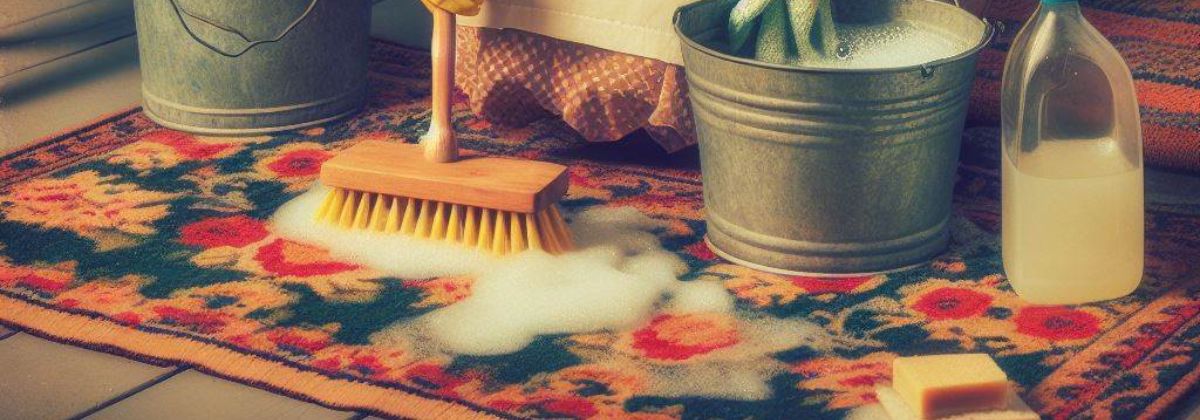29 Feb Dos and Don’ts of Cleaning Rugs
Rugs, those often-overlooked contributors to the ambience of our homes, play a vital role in decoration and maintaining cleanliness and comfort. Yet, the quest for a pristine rug can be challenging, with many pitfalls. In this guide, we’ll delve into the dos and don’ts of cleaning rugs, shedding light on the intricacies of rug care. Join us as we explore the nuances that will help you keep your rugs fresh, vibrant, and welcoming for years.
Dos and Don’ts of Cleaning Rugs
Dos of Cleaning Rugs
- Regular Vacuuming: Investing in a high-quality vacuum cleaner is paramount for upkeep of your rugs. When selecting a vacuum cleaner, choosing one with adjustable height settings is essential. This feature will allow you to easily switch between different rug thicknesses, ensuring your vacuum cleaner can effectively clean all carpets and rugs in your home. Aim to vacuum high-traffic areas at least twice a week, preventing the accumulation of dirt and debris that can prematurely age your rug.
- Immediate Stain Treatment: Stains are the nemesis of rug owners, but swift action can save the day. Whether it’s a spilt drink or a muddy footprint, address stains immediately. Utilise gentle cleaning solutions suitable for your rug’s material, remembering to blot the stain instead of rubbing it to prevent further damage.
- Professional Cleaning: While regular maintenance is essential, consider the power of professional rug cleaning. Schedule a professional cleaning at least once a year to remove deep-seated dirt and allergens. This becomes even more crucial for delicate or antique rugs, ensuring longevity and preserving aesthetic appeal.
- Rotation and Sun Exposure: Extend the life of your rug by implementing a simple yet effective strategy: rotation. Regularly rotate your rug to promote even wear, preventing specific areas from becoming worn out more quickly. Embrace natural sunlight for its sanitising properties, but be cautious about prolonged exposure to avoid fading and fibre damage.
Don’ts of Cleaning Rugs
- Avoiding Harsh Chemicals: It is advisable to avoid using harsh chemicals while cleaning your rug as they can damage its delicate fibres, leading to discolouration and early wear and tear. Instead, use eco-friendly cleaning solutions or natural ingredients like vinegar and baking soda. Before using any cleaning solution on the entire rug, always conduct a patch test on a small, inconspicuous area to ensure it is safe.
- No Direct Sunlight: While sunlight has natural disinfectant properties, resist the temptation to place your rugs in direct sunlight for extended periods. Prolonged exposure can result in fading and damage to the rug fibres. If sunlight is unavoidable, consider using window treatments to filter harmful UV rays and protect your rug’s vibrancy.
- Over-Wetting the Rug: Excessive moisture is a rug’s nemesis, creating a breeding ground for mould and mildew. When cleaning your carpet, avoid over-wetting it. Use minimal water and ensure thorough drying by ventilating the room or using fans. This not only safeguards your rug but also promotes a healthier living environment.
- Ignoring Rug Pads: Rug pads are unsung heroes in rug care. Neglecting them can lead to slipping, reduced cushioning, and potential damage to your rug and flooring. Invest in a suitable rug pad for your flooring type to prevent abrasion and enhance the overall longevity of your carpet.
- Skipping Regular Inspections: Neglecting regular inspections is a cardinal sin in rug maintenance. Vigilance is vital to spotting potential issues early on. Look for signs of wear, loose fibres, or any unwelcome critters. Addressing these issues promptly preserves the rug’s aesthetic and ensures its durability.
DIY Cleaning Tips
- Baking Soda for Odor Removal: For a guaranteed effective and natural way to eliminate unpleasant odours and absorb excess moisture from your rug, turn to baking soda. Sprinkle a generous amount on your rug and let it sit for a few hours. Then, vacuum thoroughly to reveal a refreshed and odour-free rug. Trust in the power of baking soda to leave your rug smelling fresh and clean.
- Vinegar Solution for Stain Removal: Create a DIY stain-busting solution by combining equal parts white vinegar and water. This potent mixture works wonders on various stains. However, always conduct a patch test on a small, inconspicuous area to ensure compatibility with your rug’s material. Once confirmed, apply the solution to the stain, blotting with a clean cloth until the blemish disappears.
- Steam Cleaning at Home: Investing in a reliable steam cleaner opens the possibility of deep cleaning your rug at home. Follow the manufacturer’s instructions carefully, ensuring your rug is suitable for steam cleaning. This method eliminates embedded dirt and allergens, breathing new life into your rug. Remember to allow ample time for the carpet to dry completely after steam cleaning.
The Last Word
Maintaining clean and vibrant rugs involves a delicate dance between proactive care and avoiding common pitfalls. By adhering to the dos and steering clear of don’ts outlined in this guide, you can ensure that your rugs serve as aesthetic assets and contribute to a healthy and welcoming living space.
Taking good care of your rugs is important to preserve their beauty and functionality. Regular vacuuming, professional cleaning when needed, and using natural remedies for stains are all important steps to maintain your rugs. Additionally, rotating your rugs regularly will ensure even wear, and it’s important to avoid exposing them to direct sunlight for prolonged periods.
FAQs
- How often should I vacuum my rug?
Regular vacuuming is recommended at least twice a week, particularly in high-traffic areas, to prevent the accumulation of dirt and debris.
- Can I use bleach to remove stains from my rug?
It’s advised to avoid harsh chemicals like bleach as they can damage rug fibres. Opt for gentler, eco-friendly solutions or natural remedies like vinegar and baking soda.
- Is professional rug cleaning necessary annually?
Yes, professional rug cleaning at least once a year is beneficial to remove deep-seated dirt and allergens, ensuring the longevity of your rug.
- What should I do if my rug gets soaked in water?
Avoid over-wetting your rug. Use minimal water during cleaning, and ensure thorough drying by ventilating the room or using fans to prevent mould and mildew.
- Are all rug pads suitable for any flooring?
No, choosing a rug pad suitable for your specific flooring type is essential to prevent slipping, provide cushioning, and protect the rug and the floor.




Sorry, the comment form is closed at this time.